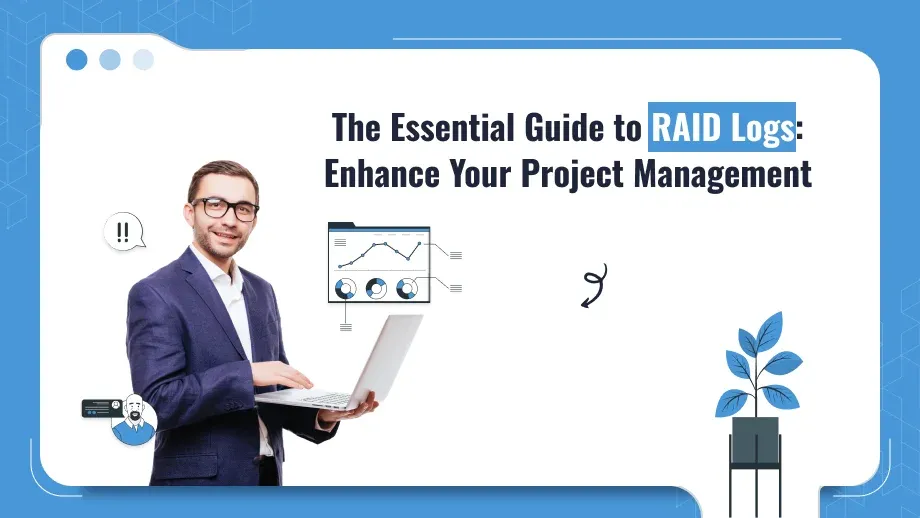
Achieving project success in project management requires effective RAID project management and clear communication. The RAID log is an essential tool that project managers use to ensure efficient processes and openness. Teams must effectively manage Risks, Assumptions, Issues, and Dependencies (RAID) for projects to succeed, and this essential document makes this possible. This article will discuss the value of a RAID log, how to create and manage one, and how to use it most effectively over the course of a project.
What is a RAID Log?
A RAID Log is a project management tool that uses an organized way to track essential project characteristics like risks, assumptions, issues, and dependencies. It is a centralized document that allows project managers to properly record, monitor, and manage various components. By keeping a RAID Log, teams may guarantee that all project stakeholders are aware of the present status and any prospective difficulties.
The RAID Full Form Project Management
In project management, RAID stands for:
- R: Risks
- A: Assumptions
- I: Issues
- D: Dependencies
Each component is critical to managing project complexity and achieving good results.
The Components of a RAID Log
- Risks:
- Risks are potential events or situations that could negatively impact the project’s objectives. These can include anything from budget overruns and resource shortages to technological issues and regulatory changes.
- Example: There is a chance that a crucial team member would leave the company, which could affect project schedules.
- Assumptions:
- Issues:
- Issues are problems that have already occurred and need immediate attention. These can derail project progress if not addressed promptly.
- Example: A significant software flaw that prevents the project from moving forward is an issue that needs to be resolved.
- Dependencies:
- Dependencies are relationships between tasks where completing one activity is required to finish another. Determining relationships is essential for efficient resource allocation and scheduling.
- Example: The completion of a design phase may depend on the approval of a budget, making it essential to track this dependency.
The Importance of a RAID Log in Project Management
Implementing a RAID log in project management provides several advantages that contribute to successful project outcomes:
Enhanced Risk Management
Early risk identification and documentation allows teams to create mitigation plans that lessen the possibility of adverse effects. By ensuring that hazards are regularly tracked and managed, the RAID log improves the overall health of the project.
Improved Communication
A RAID journal promotes openness and informs all parties involved about the progress of the project. Sharing and updating the RAID on a regular basis promotes cooperation and open communication, guaranteeing that everyone is on the same page on the goals of the project.
Proactive Problem Solving
When problems are recorded in a RAID log, they can frequently be resolved more successfully during a project. Teams can minimize disruptions and prevent escalation by identifying and discussing problems early on and creating workable plans to address them.
Better Decision-Making
Project managers can make better choices about scheduling, priority, and resource allocation if they have a thorough understanding of assumptions and dependencies. Throughout the project, the RAID record serves as a point of reference for decision-making.
Gain Full Visibility on Project Risks!
Utilize our Raid to ensure proactive risk identification and mitigation strategies are in place!
How to Create a RAID Log
Creating a RAID log involves a few straightforward steps. Here’s a guide to help you establish a comprehensive RAID for your project:
Step 1: Define the Structure
Decide on the format and structure of your RAID. This could be a document, a basic spreadsheet, or a specialist project management application. Making sure the log is simple to read and update is crucial. Many project managers use a RAID log template to standardize this process, making it easier to track and manage entries.
Step 2: Populate Initial Data
Begin by filling out the initial information in each category:
- Risks: List any known risks along with their potential impact and likelihood. Consider assigning a risk owner responsible for monitoring each risk.
- Assumptions: Document all assumptions made during project planning, including their potential impact on the project.
- Issues: Capture any existing issues that require immediate attention, including their status and assigned resolution owner.
- Dependencies: Identify key dependencies between tasks, noting which tasks rely on others for completion.
Step 3: Regularly Update the Log
As a living record, a RAID log should be updated frequently during the course of a project. Plan recurring evaluations to make sure all data is correct and up to date. This can be part of project status meetings or milestones.
Step 4: Share with Stakeholders
Ensure that the RAID log is accessible to all project stakeholders. Regularly share updates and encourage feedback. This promotes accountability and keeps everyone informed of any changes.
Best Practices for Using a RAID Log
To maximize the effectiveness of your RAID log, consider the following best practices:
1. Keep it Simple
A cluttered or overly complex RAID log can lead to confusion. Aim for clarity by using straightforward language and concise entries. Make sure that everyone is familiar with the terms and avoid using too much jargon.
2. Be Specific
Be as detailed as you can when recording risks, problems, assumptions, and dependencies. Better decision-making is made possible by stakeholders’ increased understanding of the significance and context of each item.
3. Assign Ownership
Assigning ownership to each entry in the RAID log fosters accountability. This ensures that someone is responsible for monitoring and addressing each risk or issue, promoting proactive management.
4. Review Regularly
Plan frequent evaluations of the RAID to make sure it stays current and applicable. This can be carried out at significant project milestones or at status meetings.
5. Encourage Collaboration
Team members should be encouraged to add to the RAID log. This cooperative method promotes open communication about possible risks and problems as well as a sense of responsibility.
Integrating a RAID Log with Project Management Tools
Many project management tools offer features that can help you create and maintain a RAID log more effectively. Here are some tools to consider:
1. Microsoft Excel or Google Sheets
Using a simple spreadsheet allows for easy customization and sharing. You can create columns for each RAID component and easily update and share the document with stakeholders.
2. Project Management Software
Tools like Trello, offer features that allow you to create dedicated boards or tasks for RAID components. These platforms enable easy collaboration and integration with other project management activities.
3. Specialized Risk Management Software
Consider using specialized software designed for risk and issue management. Tools like Risk Watch or Risk Matrix can provide advanced features for tracking and analyzing risks more effectively.
The RAID Register in Project Management
A RAID register project management serves as an organized log that keeps track of all RAID elements throughout the project lifecycle. It is essential for:
- Maintaining a comprehensive overview of the project’s health.
- Ensuring proactive management of risks and issues.
- Facilitating discussions during project meetings.
By utilizing a RAID register, project managers can better understand the project dynamics and make informed decisions that align with the overall project goals.
Employee Performance Evaluation and Engagement Tools
In the context of project management, effective tools for Employee Performance Evaluation and Employee Engagement Survey Tools can also be integrated into the RAID framework. By tracking employee performance and engagement metrics alongside risks and issues, project managers can identify potential challenges and opportunities for improvement within the team.
Integrating Employee Engagement Tools
Project success depends on team morale and productivity, which can be obtained by using employee engagement survey tools. Project managers can make better judgments on team dynamics and resource allocation by incorporating feedback from these tools into their RAID.
Conclusion
Including a RAID log in your project management processes can significantly enhance the way you handle risks, assumptions, problems, and dependencies. This useful tool not only improves communication and decision-making but also fosters an accountable culture and proactive problem-solving within your team.
Your project team can overcome obstacles and achieve project success by developing an organized RAID, updating it frequently, and disseminating it to stakeholders. Embrace the power of the raid to elevate your project manager software practices with Superworks and achieve your project goals with confidence.






